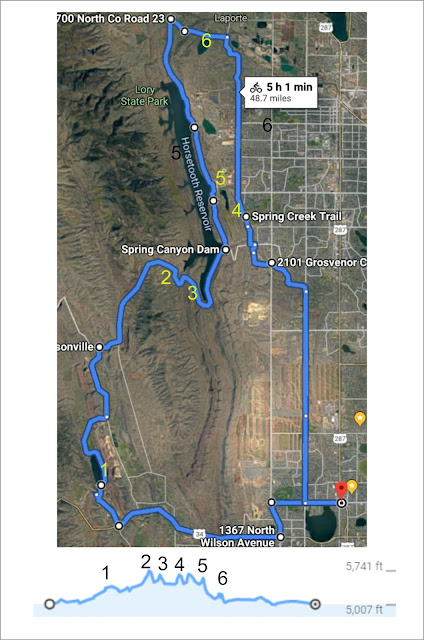Happy Birthday Jimmie
Sept 22, 2012
Dear Jimmie,
This is a letter I
wrote to Jimmie Heuga, ski racer, MS champion, my pedal partner on my first 150 Bike MS
ride. His was the inspiration for Can Do
MS in Vail. September 22 was Jimmie’s birthday and he died February 2010. Two years later, on his birthday, I did a
bike ride that was a challenge for me. This is a letter I wrote to him about
the ride.
Dear Jimmie,
This is a letter I
wrote to Jimmie Heuga, ski racer, MS champion, my pedal partner on my first 150 Bike MS
ride. His was the inspiration for Can Do
MS in Vail. September 22 was Jimmie’s birthday and he died February 2010. Two years later, on his birthday, I did a
bike ride that was a challenge for me. This is a letter I wrote to him about
the ride.
On Saturday the 22nd, 4 friends and I rode a bicycle ride I
tagged as the CanDo 50. The ride heads
west from Loveland. At the base of the foothills, the route turns north to
Mansoville, which begins the climbs over the Horsetooth Reservoir Hills. Just
before Bellvue is Bringham Hill Road that heads back east to Fort Collins. At Overland Trail, we head south on streets and trails to Loveland.
At the start, the weather was slightly hazy and cool. I
admit I was worried about doing this ride because I did not know if I could
climb the six Horsetooth hills in the same ride. While the hills are not much
by Colorado climbs, to me each represents overcoming MS challenges. When I started riding to improve my overall
health and put my MS on notice that I was in charge, I remember each of those
hills because many times I had to get off the bike and walk up them.
By mid-morning, the haze is lifting and the two of the west Horsetooth
hills are finished. Because I trained on those hills, claiming them was still
work, but not difficult.
A turn north and across the dam, the forth ill is a short
steep climb above the reservoir. Silly, how sometimes just the thought of a
thing will block success. Months before today, I walked that hill at least five
times or more. At the base, looking up I said to myself, “That’s not much of a
hill, what are you worried about?” Sure enough Jimme, it was not much of a hill
today. Next was hill 5, it is long and steep, and provokes heavy breathing, but
the MS never fatigued. The downhill is great Hill six is a bump but it marks the turn back to
Loveland.
I am sure you remember, that climbing hills with MS takes
special conditioning, the descent takes even more conditioning. Because downhill is faster, it requires
faster reaction times and coordination. It’s the same for all riders, but for
MS’ers, fatigue is riding out in front looking for a way to cause trouble. You get to the top, legs are burning,
lungs gasping, heart-pounding, arms and
hands weak from gripping the handlebar, and you see that downhill. In quick
order, not only does the ride focus change, but you must shift from low gears
to high gears, test brakes, relax tense muscles, change line-of-sight focus,
switch mental fears, watch for obstacles, plan a safe path, adjust riding
positions, anticipate curves, heighten the back sense, and then look
for that downhill freedom path to make the ride.
For me
as an MS rider, both the climb and the descent have MS challenges. MS has no place is during the downhill ride. The
MS cannot catch me there. I let go of the struggles, trust my bike, tuck down,
smile and laugh at the fatigue.
By noon, my friends peeled off, each heading home. That left
three miles to finish the ride by myself. This was a great day because those last
minutes gave me time to reflect on the ride and remember the one time I met
you, the day you signed my helmet as my first pedal partner. As an MS Ambassador, I told that story
many times and the importance of fighting MS in many ways.
At the end, the CanDo ride was 47 miles. I rode the 6 hills
without walking a single one. After
getting back to the start, I still had a couple of miles to get home. No
problem. We had a great ride pedal
partner.
Happy Birthday, Jimmie!




